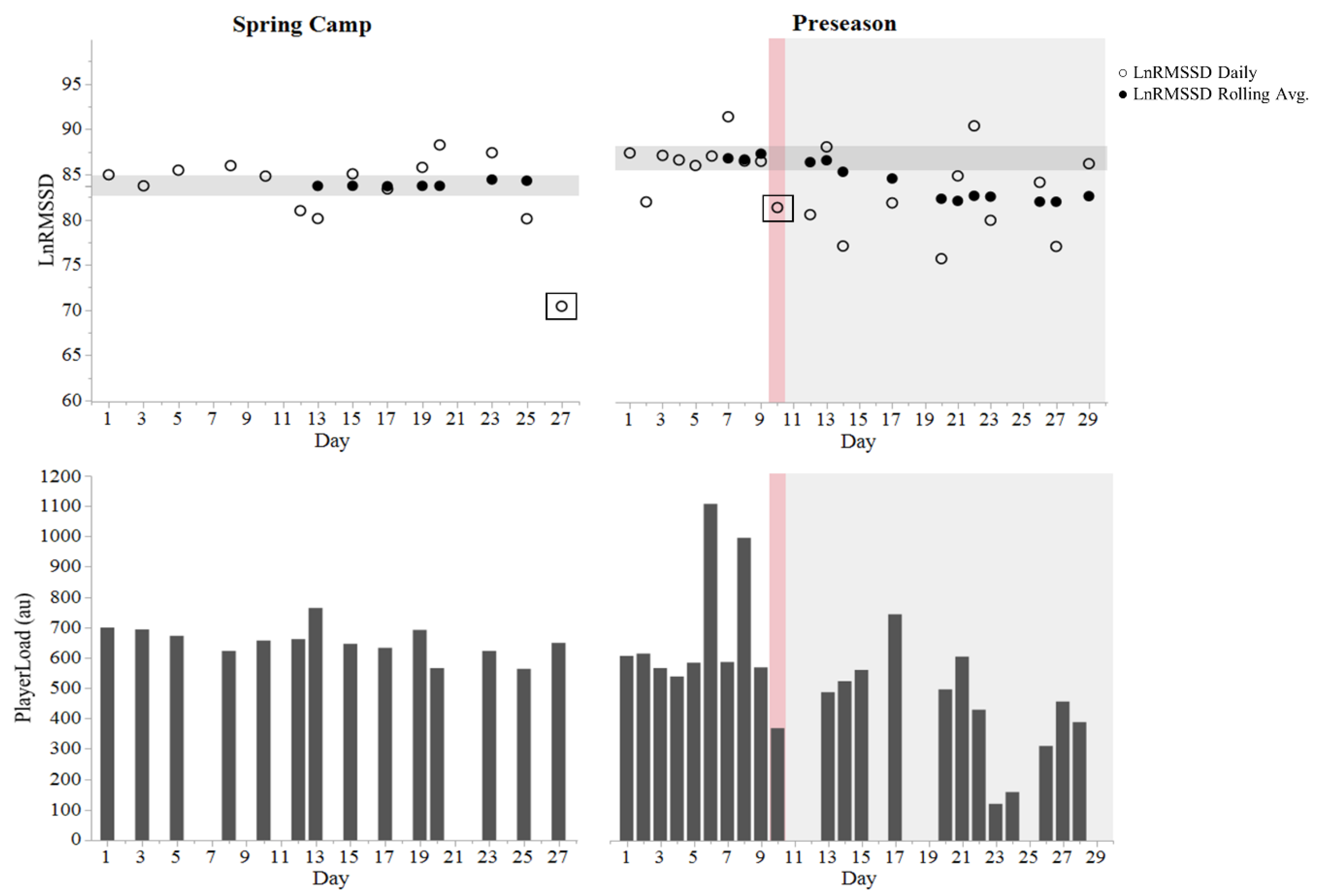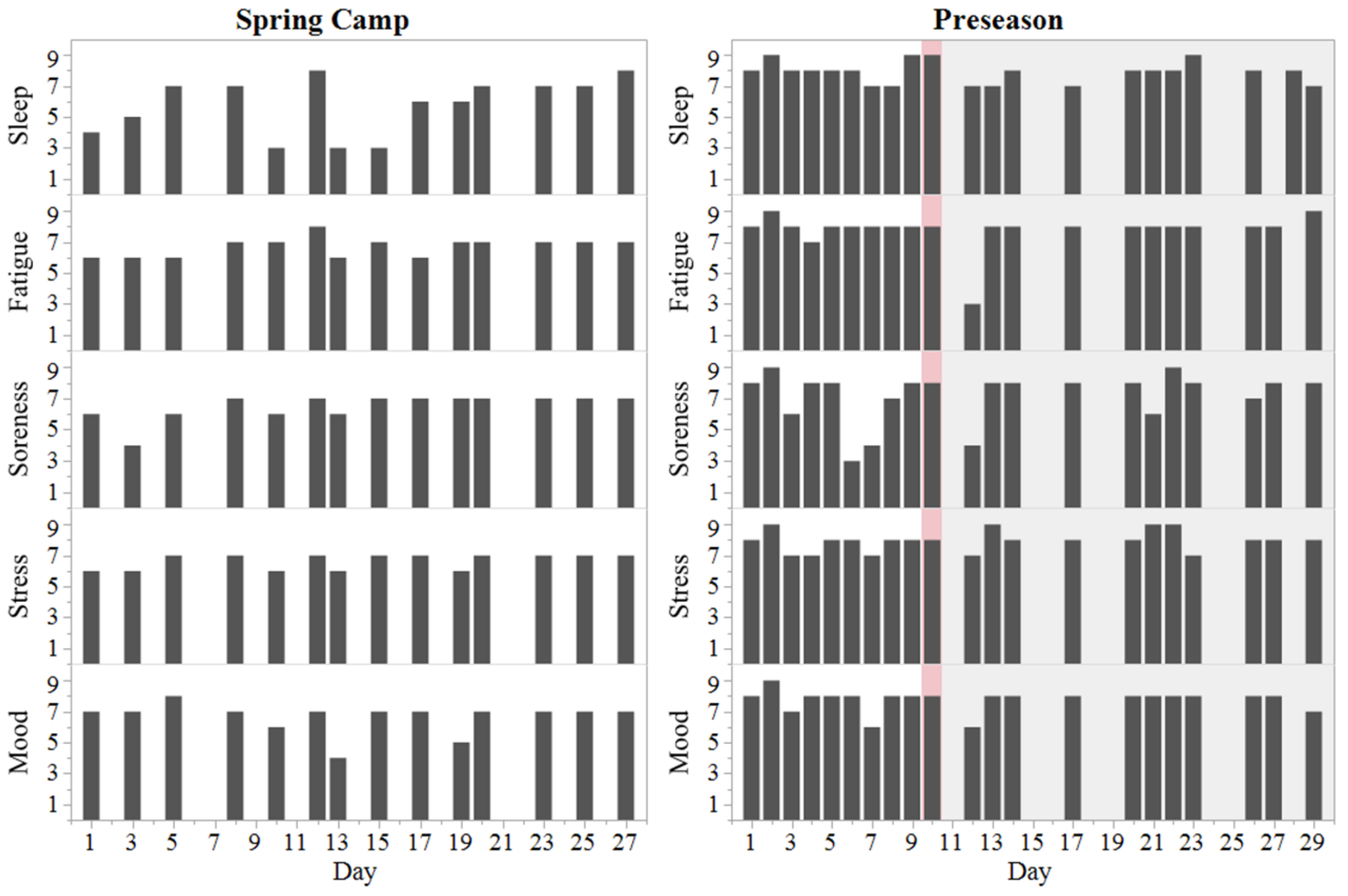Daily Heart Rate Variability before and after Concussion in an American College Football Player
Abstract
1. Introduction
2. Materials and Methods
2.1. Participant
2.2. Procedures
2.2.1. Observation Period
2.2.2. Heart Rate Variability
2.2.3. Training Load
2.2.4. Subjective Indicators of Wellbeing
2.2.5. Concussion Testing
2.3. Statistical Analysis
3. Results
4. Discussion
5. Conclusions
Author Contributions
Funding
Acknowledgments
Conflicts of Interest
References
- Flatt, A.A.; Esco, M.R.; Allen, J.R.; Robinson, J.B.; Earley, R.L.; Fedewa, M.V.; Bragg, A.; Keith, C.M.; Wingo, J.E. Heart rate variability and training load among national collegiate athletic association division 1 college football players throughout spring camp. J. Strength. Cond. Res. 2017, 32, 3127–3134. [Google Scholar] [CrossRef] [PubMed]
- Flatt, A.A.; Esco, M.R.; Allen, J.R.; Robinson, J.B.; Bragg, A.; Keith, C.M.; Fedewa, M.V.; Earley, R.L. Cardiac-autonomic responses to in-season training among division-1 college football players. J. Strength. Cond. Res. 2019. [Google Scholar] [CrossRef] [PubMed]
- Wellman, A.D.; Coad, S.C.; Flynn, P.J.; Climstein, M.; McLellan, C.P. Movement demands and perceived wellness associated with preseason training camp in NCAA division I college football players. J. Strength. Cond. Res. 2017, 31, 2704–2718. [Google Scholar] [CrossRef] [PubMed]
- Fullagar, H.H.; Govus, A.; Hanisch, J.; Murray, A. The time course of perceptual recovery markers after match play in division ia college American football. Int. J. Sports Physiol. Perf. 2017, 12, 1264–1266. [Google Scholar] [CrossRef]
- Laborde, S.; Mosley, E.; Mertgen, A. A unifying conceptual framework of factors associated to cardiac vagal control. Heliyon 2018, 4, e01002. [Google Scholar] [CrossRef]
- Dompier, T.P.; Kerr, Z.Y.; Marshall, S.W.; Hainline, B.; Snook, E.M.; Hayden, R.; Simon, J.E. Incidence of concussion during practice and games in youth, high school, and collegiate American football players. JAMA Pediat. 2015, 169, 659–665. [Google Scholar] [CrossRef] [PubMed]
- De Beaumont, L.; Theoret, H.; Mongeon, D.; Messier, J.; Leclerc, S.; Tremblay, S.; Ellemberg, D.; Lassonde, M. Brain function decline in healthy retired athletes who sustained their last sports concussion in early adulthood. Brain 2009, 132, 695–708. [Google Scholar] [CrossRef]
- De Beaumont, L.; Lassonde, M.; Leclerc, S.; Théoret, H. Long-term and cumulative effects of sports concussion on motor cortex inhibition. Neurosurgery 2007, 61, 329–337. [Google Scholar] [CrossRef]
- Ellis, M.J.; Leddy, J.J.; Willer, B. Physiological, vestibulo-ocular and cervicogenic post-concussion disorders: An evidence-based classification system with directions for treatment. Brain Inj. 2015, 29, 238–248. [Google Scholar] [CrossRef]
- Senthinathan, A.; Mainwaring, L.M.; Hutchison, M. Heart rate variability of athletes across concussion recovery milestones: A preliminary study. Clin. J. Sport Med. 2017, 27, 288–295. [Google Scholar] [CrossRef] [PubMed]
- Maruta, J.; Lee, S.W.; Jacobs, E.F.; Ghajar, J. A unified science of concussion. Ann N Y Acad. Sci. 2010, 1208, 58–66. [Google Scholar] [CrossRef]
- Abaji, J.P.; Curnier, D.; Moore, R.D.; Ellemberg, D. Persisting effects of concussion on heart rate variability during physical exertion. J. Neurotrauma 2016, 33, 811–817. [Google Scholar] [CrossRef]
- Conder, R.L.; Conder, A.A. Heart rate variability interventions for concussion and rehabilitation. Front. Psychol. 2014, 5, 890. [Google Scholar] [CrossRef]
- Flatt, A.A.; Howells, D.; Williams, S. Effects of consecutive domestic and international tournaments on heart rate variability in an elite rugby sevens team. J. Sci. Med. Sport 2019, 22, 616–621. [Google Scholar] [CrossRef]
- Flatt, A.A.; Howells, D. Effects of varying training load on heart rate variability and running performance among an Olympic rugby sevens team. J. Sci. Med. Sport 2018, 22, 222–226. [Google Scholar] [CrossRef] [PubMed]
- Nakamura, F.Y.; Pereira, L.A.; Esco, M.R.; Flatt, A.A.; Moraes, J.E.; Abad, C.C.C.; Loturco, I. Intraday and interday reliability of ultra-short-term heart rate variability in rugby union players. J. Strength. Cond. Res. 2017, 31, 548–551. [Google Scholar]
- Flatt, A.A.; Esco, M.R. Evaluating individual training adaptation with smartphone-derived heart rate variability in a collegiate female soccer team. J. Strength. Cond. Res. 2016, 30, 378–385. [Google Scholar] [CrossRef]
- Flatt, A.A.; Hornikel, B.; Esco, M.R. Heart rate variability and psychometric responses to overload and tapering in collegiate sprint-swimmers. J. Sci. Med. Sport. 2017, 20, 606–610. [Google Scholar] [CrossRef]
- Reed, N.; Murphy, J.; Dick, T.; Mah, K.; Paniccia, M.; Verweel, L.; Dobney, D.; Keightley, M. A multi-modal approach to assessing recovery in youth athletes following concussion. JoVE 2014, 91, e51892. [Google Scholar] [CrossRef]
- Esco, M.R.; Flatt, A.A.; Nakamura, F.Y. Agreement between a smart-phone pulse sensor application and ecg for determining lnrmssd. J. Strength. Cond. Res. 2016, 31, 380–385. [Google Scholar] [CrossRef]
- Boyd, L.J.; Ball, K.; Aughey, R.J. The reliability of minimaxx accelerometers for measuring physical activity in Australian football. Int. J. Sports Physiol. Perf. 2011, 6, 311–321. [Google Scholar] [CrossRef]
- McLean, B.D.; Coutts, A.J.; Kelly, V.; McGuigan, M.R.; Cormack, S.J. Neuromuscular, endocrine, and perceptual fatigue responses during different length between-match microcycles in professional rugby league players. Int. J. Sports Physiol. Perf. 2010, 5, 367–383. [Google Scholar] [CrossRef]
- Flatt, A.A.; Esco, M.R.; Nakamura, F.Y. Association between subjective indicators of recovery status and heart rate variability among divison-1 sprint-swimmers. Sports 2018, 6, 93. [Google Scholar] [CrossRef]
- Hopkins, W.; Marshall, S.; Batterham, A.; Hanin, J. Progressive statistics for studies in sports medicine and exercise science. Med. Sci. Sports Exerc. 2009, 41, 3–13. [Google Scholar] [CrossRef]
- Plews, D.J.; Laursen, P.B.; Kilding, A.E.; Buchheit, M. Heart rate variability in elite triathletes, is variation in variability the key to effective training? A case comparison. Eur. J. Appl. Physiol. 2012, 112, 3729–3741. [Google Scholar] [CrossRef] [PubMed]
- Cohen, J. Statistical Power Analysis for the Behavioral Sciences, 2nd ed.; Routledge: Hillsdale, NJ, USA, 1988. [Google Scholar]
- Stanley, J.; Peake, J.M.; Buchheit, M. Cardiac parasympathetic reactivation following exercise: Implications for training prescription. Sports Med. 2013, 43, 1259–1277. [Google Scholar] [CrossRef]
- Tulppo, M.P.; Kiviniemi, A.M.; Junttila, M.J.; Huikuri, H.V. Home monitoring of heart rate as a predictor of imminent cardiovascular events. Front. Physiol. 2019, 10, 341. [Google Scholar] [CrossRef] [PubMed]
- La Fountaine, M.F. An anatomical and physiological basis for the cardiovascular autonomic nervous system consequences of sport-related brain injury. Int. J. Psychophysiol. 2017, 132, 155–166. [Google Scholar] [CrossRef] [PubMed]
- Leddy, J.; Hinds, A.; Sirica, D.; Willer, B. The role of controlled exercise in concussion management. PMR 2016, 8, S91–S100. [Google Scholar] [CrossRef] [PubMed]
- Sharp, D.J.; Beckmann, C.F.; Greenwood, R.; Kinnunen, K.M.; Bonnelle, V.; De Boissezon, X.; Powell, J.H.; Counsell, S.J.; Patel, M.C.; Leech, R. Default mode network functional and structural connectivity after traumatic brain injury. Brain 2011, 134, 2233–2247. [Google Scholar] [CrossRef] [PubMed]
- Thayer, J.F.; Hansen, A.L.; Saus-Rose, E.; Johnsen, B.H. Heart rate variability, prefrontal neural function, and cognitive performance: The neurovisceral integration perspective on self-regulation, adaptation, and health. Ann. Behav. Med. 2009, 37, 141–153. [Google Scholar] [CrossRef]
- Winkelmann, T.; Thayer, J.F.; Pohlack, S.; Nees, F.; Grimm, O.; Flor, H. Structural brain correlates of heart rate variability in a healthy young adult population. Brain Struct. Funct. 2017, 222, 1061–1068. [Google Scholar] [CrossRef] [PubMed]
- Jennings, J.R.; Sheu, L.K.; Kuan, D.C.H.; Manuck, S.B.; Gianaros, P.J. Resting state connectivity of the medial prefrontal cortex covaries with individual differences in high-frequency heart rate variability. Psychophysiology 2016, 53, 444–454. [Google Scholar] [CrossRef] [PubMed]
- Holzman, J.B.; Bridgett, D.J. Heart rate variability indices as bio-markers of top-down self-regulatory mechanisms: A meta-analytic review. Neurosci. Biobehav. Rev. 2017, 74, 233–255. [Google Scholar] [CrossRef] [PubMed]
- Niogi, S.; Mukherjee, P.; Ghajar, J.; Johnson, C.; Kolster, R.; Sarkar, R.; Lee, H.; Meeker, M.; Zimmerman, R.; Manley, G. Extent of microstructural white matter injury in postconcussive syndrome correlates with impaired cognitive reaction time: A 3t diffusion tensor imaging study of mild traumatic brain injury. Am. J. Neuroradiol. 2008, 29, 967–973. [Google Scholar] [CrossRef] [PubMed]
- Maruta, J.; Suh, M.; Niogi, S.N.; Mukherjee, P.; Ghajar, J. Visual tracking synchronization as a metric for concussion screening. J. Head. Trauma. Rehabil. 2010, 25, 293–305. [Google Scholar] [CrossRef]
- La Fountaine, M.F.; Gossett, J.D.; De Meersman, R.E.; Bauman, W.A. Increased qt interval variability in 3 recently concussed athletes: An exploratory observation. J. Athl. Train. 2011, 46, 230–233. [Google Scholar] [CrossRef]


| Observation Date | Symptom Number 1 | Symptom Severity 2 | SAC Score 3 |
|---|---|---|---|
| Baseline | 0 | 0 | 27 |
| Day of Injury | 8 | 22 | 27 |
| Post-Injury Day 1 | 6 | 8 | - |
| Post-Injury Day 2 | 18 | 36 | - |
| Post-Injury Day 3 | 4 | 7 | 29 |
| Post-Injury Day 4 | - | - | - |
| Post-Injury Day 5 | 2 | 2 | - |
| Post-Injury Day 6 | 0 | 0 | 29 |
© 2019 by the authors. Licensee MDPI, Basel, Switzerland. This article is an open access article distributed under the terms and conditions of the Creative Commons Attribution (CC BY) license (http://creativecommons.org/licenses/by/4.0/).
Share and Cite
Flatt, A.A.; Wilkerson, G.B.; Allen, J.R.; Keith, C.M.; Esco, M.R. Daily Heart Rate Variability before and after Concussion in an American College Football Player. Sports 2019, 7, 97. https://doi.org/10.3390/sports7050097
Flatt AA, Wilkerson GB, Allen JR, Keith CM, Esco MR. Daily Heart Rate Variability before and after Concussion in an American College Football Player. Sports. 2019; 7(5):97. https://doi.org/10.3390/sports7050097
Chicago/Turabian StyleFlatt, Andrew A., Gary B. Wilkerson, Jeff R. Allen, Clay M. Keith, and Michael R. Esco. 2019. "Daily Heart Rate Variability before and after Concussion in an American College Football Player" Sports 7, no. 5: 97. https://doi.org/10.3390/sports7050097
APA StyleFlatt, A. A., Wilkerson, G. B., Allen, J. R., Keith, C. M., & Esco, M. R. (2019). Daily Heart Rate Variability before and after Concussion in an American College Football Player. Sports, 7(5), 97. https://doi.org/10.3390/sports7050097







